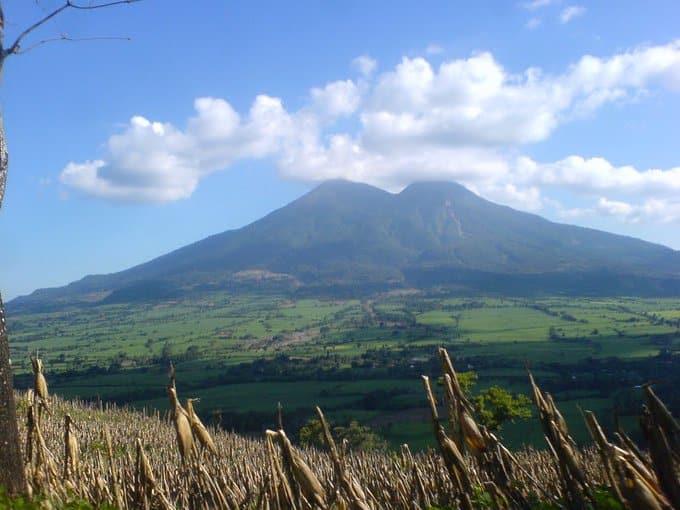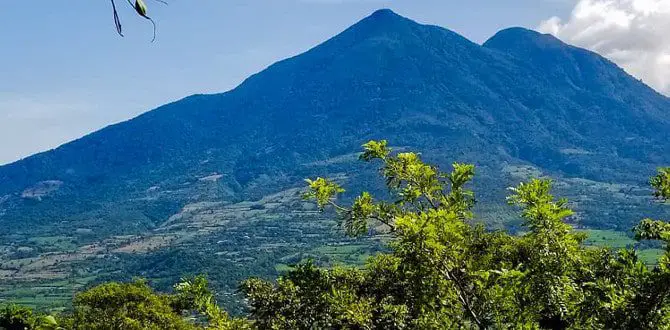
The San Vicente volcano El Salvador is a twin-peaked stratovolcano, also known as Chichontepec or Las Chiches volcano; it is located in the central region of the country, next to the town of San Vicente. This stratovolcano is the second-highest volcano in El Salvador, next to the Santa Ana volcano.
In the indigenous Nahuat language, Chichontepec means the mountain of two breasts; therefore, locals refer to this volcano as Las Chiches volcano or the breast volcano in English.
Short info about San Vicente volcano.
The San Vicente volcano has two craters, one in each summit, but they are not located all the way at the top.
SEE ALSO: El Salvador Tourism: A Journey Through Pristine Beaches, Colorful Towns, and Enchanting Parks
The volcano’s top or summit is covered by dense vegetation, which makes it difficult to hike; Now, if you do climb it, the views from the volcano can be obstructed by the dense forest.
There is a possibility that the San Vicente volcano might still be active; however, this volcano has no known historical eruptions.
On the northern and southern flanks, Chichontepec volcano is covered by lava flows from the center vent. However, the lava flows on the eastern side originated from a vent on the upper side of the volcano.
When visiting this volcano, you will find many hot springs and fumaroles, especially on the northern and western flanks of the volcano.
The San Vicente volcano or Chichontepec is one of the big three volcanoes in El Salvador, the others being the Chaparrastique in San Miguel, and the Santa Ana volcano.
SEE ALSO: El Salvador’s Ecotourism. 10 Incredible Salvadoran Natural Parks Worth Exploring!
Visiting San Vicente volcano El Salvador.
The San Vicente volcano is an impressive stratovolcano that is visible from many parts of the country, from San Salvador to San Miguel.
There are basically two ways to experience this volcano, one is to hike it, and the other is to appreciate it from afar.
Hiking the San Vicente volcano.
Hiking this volcano is popular with those who like a challenge; this volcano is not the prettiest or easiest to hike.
Because of the difficulty and the fact that the trails to hike this volcano are basically non-existing, I encourage you to arrange the hike using a Salvadoran tour company.
Almost everyone will hike the eastern peak, all the way to the military base; yes, there is an abandoned military base at the top of this volcano.
The hike to the top of the Chichontepec volcano is not an attractive one; there are absolutely no views until you reach the military base on the summit.
The views from the helicopter pad, at the military base, are simply amazing; of course, this is if you visit on a clear day.
On a clear day, from the summit of the Chichontepec volcano, you can see the Santa Ana volcano in the western part of the country; and you can also see the Chaparrastique volcano, which sits in the eastern part of the country. The views from the volcano are incredible!
Appreciating the Chichontepec volcano from afar.
The Chichontepec volcano is a majestic stratovolcano that can be seen from many points in the central part of the country.
If you want to see this volcano by afar, I recommend you to visit the city of San Vicente or San Sebastian. From either San Vicente or San Sebastian, you ill have astonishing views of the volcano.
In addition to the two towns that I have mentioned above, there are other towns or viewpoints where you will be able to see and appreciate the volcano.

San Vicente volcano El Salvador.
As previously mentioned, the Chichontepec Volcano El Salvador is one of the big three in the country.
If you are someone who likes challenging climbs, this volcano is for you; just make sure you avoid it during the rainy season, as there are landslides that can put your life at risk.
For those of you who don’t want to hike this stratovolcano; you can see it from afar from many different locations around the volcano.




